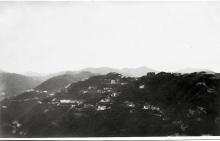70 years ago: Hong Kong's wartime diaries
22 Jan 1942: RE Jones Diary
Submitted by Admin on Sat, 2011-12-24 14:01Book / Document:Date(s) of events described:Thu, 22 Jan 1942Well darling, our Rae is 12 months old & I sincerely hope & pray that this her first birthday will be the first & last that we are parted until she leaves us to start a home of her own. I hope you had a nice little party sweetheart with one candle on the cake. God Bless you both.
22 Jan 1942, Barbara Anslow's diary
Submitted by Barbara Anslow on Tue, 2012-01-03 21:43Book / Document:Date(s) of events described:Thu, 22 Jan 1942Mum and I ate something from our frugal supplies then went room-hunting again around the blocks with Connie Hawkett, an ANS friend of Mum's. (Absolutely no one was in charge. ) Once we found an empty room with some furniture, but hastily withdrew when a Chinese who seemed to be an authority came in and said this room was reserved for Japanese administrators. A complete stranger in ANS uniform hailed Mum and said she'd found an empty room and would we like to share it.. would we!! - a small room in Block 3 overlooking the courtyard, on first floor. It was a feeling of indescribable security to be in a place where we could remain, some furniture - a spare camp bed (now mine), small chest of drawers & a glassfronted cabinet, a small table and a fireplace. We shared out shelves and drawers between us. There was also a large wooden doll's house – we were lucky, as most of the rooms were empty of furniture. Our room-mate was Mrs G. Kopeczky, Hungarian.
Later that day, able to collect some cooked rice.
((There was no way of knowing who had got into the camp except by wandering around and trying to find friends. The Japs were simply bringing people in as and when they found them, and by whatever transport was available. Everything was haphazard, how much luggage you were allowed to bring in with you depended on what space there was on the transport, and on the personal opinions of the Japs superintending your transfer. The main difficulty for most of us was that by the time we were captured, we weren't anywhere near our homes and had only a small suitcase or overnight bag, and didn't get the chance to go back to our homes to collect any possessions.
We Redwoods were particularly lucky because of Ah Ding's many journeys on foot from our flat to the Chinese hotels, bringing each time a few clothes in her little wicker basket. We found her after the war when we returned to Hong Kong after recuperation in UK. She had a good job with an army family living on the Peak, earning far more than we could afford to pay her. We always kept in touch though.
As more and more internees poured into the camp, the red brick 3-storeyed blocks used prewar as Indian Prison Warders' quarters were used as billets. They were in a valley just below the Married Quarters and had very small rooms with stone floors and Asian toilets (you squatted over a small drain, your feet planted in huge cemented footprints). These blocks were ranged round a grassed area which ran down to the barbed-wired rocky sea's edge. Other buildings in use as billets were up a steep inclined to St Stephen's College, a prewar boarding school; also used was the nearby Science Block and some bungalows which had been occupied by senior Prison Officers.
Two of our soldiers graves had been temporarily built at the top of the path up to St Stephens. One victim was the husband of a woman with a small child in camp. Other soldier victims were buried in the old Stanley cemetery; some of the Tweed Bay Hospital staff who had been killed were buried at the side of the hospital.
Some internees settled themselves in two of the bungalows when they had to move as the Japanese decided to use them as their Camp Headquarters.))
22 Jan 1942, Chronology of Events Related to Stanley Civilian Internment Camp
Submitted by brian edgar on Mon, 2012-01-16 17:00Book / Document:Date(s) of events described:Thu, 22 Jan 1942American internee Wenzell Brown goes to St. Stephen's College and has his first shower for 27 days:
The cold harsh needles of water seemed to give me new life. My razor, shaving brush, a cake of soap, toothpaste and toothbrush were, other than my blankets and the clothing I had on, my only possessions.
M. L. Bevan states in today's diary entry that the rations are 8 ounces of rice, about 3 ounces of meat and one slice of bread per day. He estimates the number of British as about 2,300 and notes some cases of dysentery.
At 4 p.m. the representatives of those living in St. Stephen's College gather for probably the first committee meeting in Stanley.
Sources:
Brown: Wenzell Brown, Hong Kong Aftermath, 1943, 99
Bevan: Typescript Of Diary, 523.1 (Bevan) 58132, held at the Imperial War Museum
St. Stephen's: John Stericker, Captive Colony, Chapter iv, page 1
22 Jan 1942, Don Ady's wartime memories
Submitted by Admin on Fri, 2012-12-07 19:41Book / Document:Date(s) of events described:Thu, 22 Jan 1942On the 22nd we were marched down the bund to a dock where we got on a launch and went to Stanley on it.
At first we were billeted with the Pommerenkes, and later the Lynns lived with us, so there were seven of us in the room.

